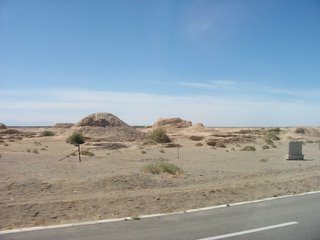•Sand accumulation and formation of sand dunes are important features in inland and coastal deserts, which are considered critical problems. There are presently about 26 large-scale ergs, which have covered 120,000 square kilometers of deserts in Iran. It is noteworthy that the most important citadel of the world (Lout) is located in Iranian desert with pyramids of more than 500 meters height. Totally, Iran covers 5 million hectares of active sand dunes.
Nebka
•Nebkas are formed where wind erosion persists. It includes regions where sediments gathered around bushes. In this case, bushes gradually go upward until roots are disconnected from underground water and bushes will die.
(Nebka, yazd-Iran)
Kalout and Yardang:
Another feature in desertified lands is Kalout and Yardang formation which is formed by wind and water erosions. Strong and lengthy raining causes the degradation of lands exposed to erosion and so soil particles will being removed and form Kalout and Yardang hills.
(Kalout, China-Cansu Province)
Salty and Clay Pans:
•These features could be seen in central lower areas (playas). The percentage of salt in these spots is very high which doesn’t let plant establish easily. These spots are barren, without any vegetation. A large portion of central Iran is covered by this phenomenon.
Dr.Mohammad , khosroshahi (Salty Kavir, Qom-Iran)





0 Comments:
Post a Comment
Subscribe to Post Comments [Atom]
<< Home